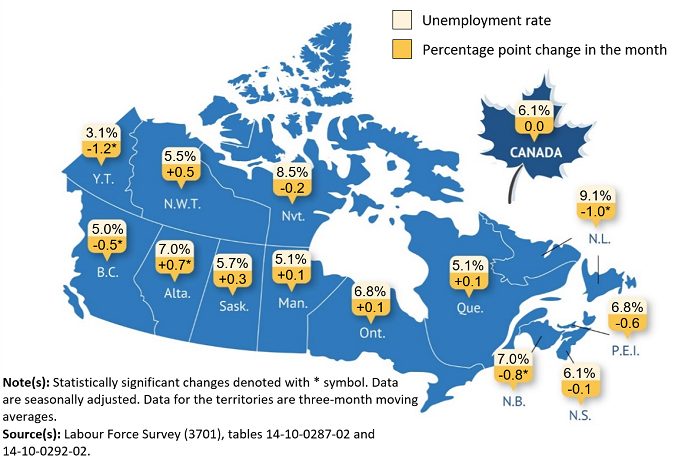Ottawa, ON, Canada (WNEWS CANADA) – Canada’s unemployment rate rose to 6.9% in April, marking the highest level since November 2024. This increase reflects a modest net gain of only 7,400 jobs during the month, signaling a stagnating labour market amid escalating trade tensions and economic uncertainty.
#StatisticsCanada attributed the high unemployment rate in Canada, which has reached nearly 1.6 million, to the impact of U.S. President #DonaldTrump’s tariffs on Canadian imports, particularly in the manufacturing sector.
In March, Trump imposed tariffs on Canadian steel and aluminum, and in April, automobiles faced tariffs. Additionally, import duties were imposed on a broad range of products, with reductions and exemptions applied to certain items. These measures have had a significant impact on businesses and households.
Provincial Unemployment Rates

The unemployment rate varied across provinces in April 2025:
- Newfoundland and Labrador: 9.6% (-0.4 percentage points)
- Prince Edward Island: 6.6% (-0.9 percentage points)
- Nova Scotia: 7.2% (+1.1 percentage points)
- New Brunswick: 6.9% (-0.1 percentage points)
- Quebec: 6.0% (+0.3 percentage points)
- Ontario: 7.8% (+0.3 percentage points)
- Manitoba: 5.3% (-0.7 percentage points)
- Saskatchewan: 4.3% (-0.6 percentage points)
- Alberta: 7.1% (no change)
- British Columbia: 6.2% (+0.1 percentage points)
- Yukon: 3.9% (-0.4 percentage points)
- Northwest Territories: 3.7% (+0.1 percentage points)
- Nunavut: 7.8% (+0.5 percentage points)
These figures indicate significant regional disparities, with the highest unemployment rates observed in Newfoundland and Labrador, and the lowest in the Northwest Territories.
Temporary Public Sector Employment
Public sector employment increased by 23,000 (+0.5%) in April, primarily due to temporary hiring associated with the federal election. This included positions related to advanced polling (April 18–21) and election day (April 28). Such temporary employment contributed to a short-term boost in public administration jobs.
The average hourly wage growth of permanent employees, a closely watched metric by the Canadian central bank to gauge inflationary trends, remained steady at 3.5% in April, matching the same rate observed in March.
Sectoral Employment Changes
- Manufacturing: Employment declined by 31,000 positions, largely due to U.S.-imposed tariffs on Canadian exports, including steel, aluminum, and automobiles.
- Public Administration: Employment rose by 37,000 (+3.0%), mainly due to temporary election-related hiring.
- Private Sector: Employment remained relatively unchanged, following a decline of 48,000 (-0.3%) in March.
- Self-Employment: Little change was observed for the third consecutive month.
Young Canadians aged 15 to 24 faced an unemployment rate of 14.1% in April, significantly higher than the national average. This demographic continues to grapple with job market entry barriers and limited opportunities, exacerbated by the current economic climate.
Economic Outlook
The Bank of Canada maintained its policy interest rate at 2.75% in April. However, with the weakening labor market, there is speculation about a potential rate cut in the coming months to stimulate economic growth. The Canadian dollar has also declined to a three-week low against the U.S. dollar, reflecting investor concerns over the country’s economic resilience amid ongoing trade disputes.
Currency swap market bets suggest odds of a 25 basis point rate cut in June exceed 55%.
The Canadian dollar was trading up 0.1% to 1.3909 U.S. dollars, or 71.90 U.S. cents. Following the release of the labour force data, yields on two-year government bonds fell 3.3 basis points to 2.586%.
The number of unemployed people, or those looking for work or on temporary layoff, increased by 39,000 or 2.6% in April, and was up by 189,000 or 13.9% on a year-over-year basis.
Statscan reported that people who were unemployed continued to face more difficulties finding work in April compared to the same period last year. Among those unemployed in March, 61% remained unemployed in April, which was almost four percentage points higher than the same period last year.
Statscan reported that the manufacturing sector, particularly affected by the tariffs and their uncertainty, shed 31,000 jobs in the month. Retail and wholesale trade also experienced a drop in the number of employed people.
In April, the employment rate, or the proportion of the working-age population employed, stood at 60.8%, marking a six-month low. This decline of 0.2 percentage points was noted in March, according to the statistics agency.
The employment rate had been depressed for most of 2023 and 2024 as population growth outpaced employment gains. However, since February, population growth has been relatively low, while employment gains have slowed.
Government Measures and Future Prospects
In response to the economic challenges, the Canadian government is exploring financial supports, including low-cost loans and tax deferrals, to assist affected industries and workers. However, the effectiveness of these measures remains to be seen, as the nation navigates a complex global trade environment and seeks to bolster its economic stability .
In April, Service Canada reduced the number of hours required for Employment Insurance and temporarily waived the one-week waiting period for new EI claims, made between March 30, 2025 and October 11, 2025.
The government also suspended the allocation of separation earnings and adjusted unemployment rates for certain regions.











